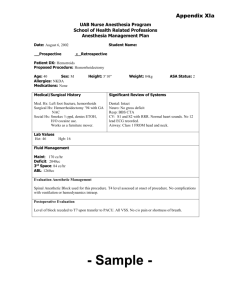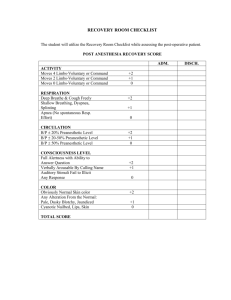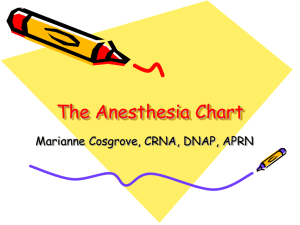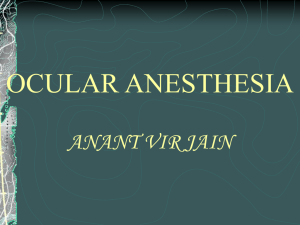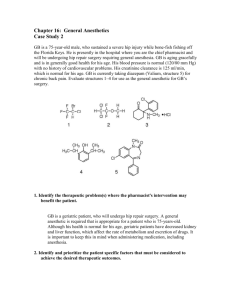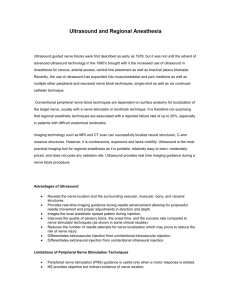Local anasthesia
advertisement
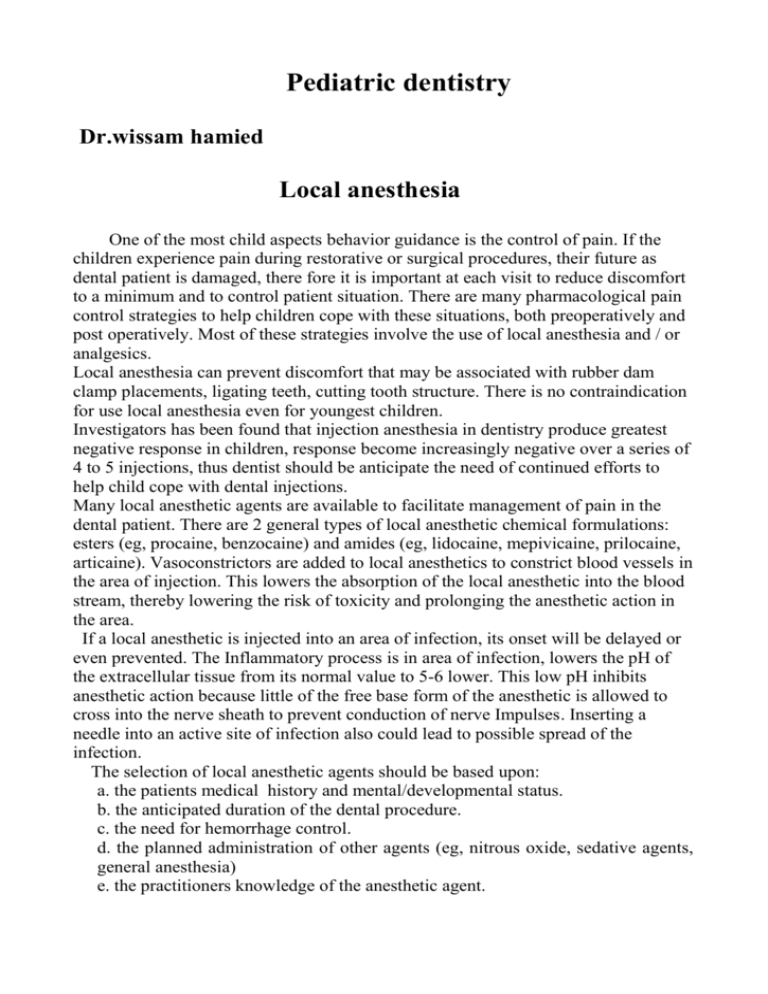
Pediatric dentistry Dr.wissam hamied Local anesthesia One of the most child aspects behavior guidance is the control of pain. If the children experience pain during restorative or surgical procedures, their future as dental patient is damaged, there fore it is important at each visit to reduce discomfort to a minimum and to control patient situation. There are many pharmacological pain control strategies to help children cope with these situations, both preoperatively and post operatively. Most of these strategies involve the use of local anesthesia and / or analgesics. Local anesthesia can prevent discomfort that may be associated with rubber dam clamp placements, ligating teeth, cutting tooth structure. There is no contraindication for use local anesthesia even for youngest children. Investigators has been found that injection anesthesia in dentistry produce greatest negative response in children, response become increasingly negative over a series of 4 to 5 injections, thus dentist should be anticipate the need of continued efforts to help child cope with dental injections. Many local anesthetic agents are available to facilitate management of pain in the dental patient. There are 2 general types of local anesthetic chemical formulations: esters (eg, procaine, benzocaine) and amides (eg, lidocaine, mepivicaine, prilocaine, articaine). Vasoconstrictors are added to local anesthetics to constrict blood vessels in the area of injection. This lowers the absorption of the local anesthetic into the blood stream, thereby lowering the risk of toxicity and prolonging the anesthetic action in the area. If a local anesthetic is injected into an area of infection, its onset will be delayed or even prevented. The Inflammatory process is in area of infection, lowers the pH of the extracellular tissue from its normal value to 5-6 lower. This low pH inhibits anesthetic action because little of the free base form of the anesthetic is allowed to cross into the nerve sheath to prevent conduction of nerve Impulses. Inserting a needle into an active site of infection also could lead to possible spread of the infection. The selection of local anesthetic agents should be based upon: a. the patients medical history and mental/developmental status. b. the anticipated duration of the dental procedure. c. the need for hemorrhage control. d. the planned administration of other agents (eg, nitrous oxide, sedative agents, general anesthesia) e. the practitioners knowledge of the anesthetic agent. Topical anesthesia. It reduce the slight discomfort that may be associated with the insertion the needle before the injection of local anesthesia. Some of these agents having disadvantages that have disagreeable taste to the child, and additional time require to apply them may allow the child become apprehensive concerning the approaching procedure. They are available in gel, liquid, ointment and pressurized spray forms, these agents apply to the oral mucosa membrane with cotton tipped applicators. A variety of anesthesia agents have been used in topical anesthesia preparations include ethylamine benzoate, butacaine sulfate, cocaine, dyclonine, lidocaine, and tetracaine. Jet injection. The jet injections instrument is based on the principle that small quantity of liquid forced through very small openings under high pressure can penetrate mucous membrane or skin without causing tissue damaged. It used by some dentist instead of using topical anesthesia, this method is quick and essential painless thought the abruptness of injection may produce momentary anxiety. It is useful in: 1. gingival anesthesia before rubber dam clamp application for isolation. 2. used for before band application of partially erupted molars . 3. used for remove of a very loose primary tooth. Selection of syringes and needles. It has been established standards for aspirating syringes for use in the administration of local anesthesia. Needle selection should allow for profound local anesthesia and adequate aspiration. Larger gauge needles provide for less deflection as the needle passes through soft tissues and for more reliable aspiration. The depth of insertion varies not only by injection technique, but also by the age and size of the patient. Dental needles are available in 3 lengths: long (32 mm), short (20 mm), and ultra short (10mm), needle gauges range from size 23-30. Recommendations: 1. For the administration of local dental anesthesia, dentists should select aspirating syringes that meet the international standards. 2. Short needles may be used for any injection in which the thickness of soft tissue is less than 20 mm and a long needle for a deeper injection into soft tissue. Any 23through 30-gauge needle may be used for intra oral injections since blood can be aspirated through all of them however, aspiration can be more difficult when smaller gauge needles are used. An extra-short needle is appropriate for infiltration injections. 3. Needles should not be bent or inserted to their hub for injections to avoid needle breakage. Supplemental injections to obtain local anesthesia The majority of local anesthesia procedures in pediatric dentistry involve traditional methods of infiltration or nerve block techniques with a dental syringe, disposable cartridges, and needles as described so far. However, several alternative techniques are available. These include computer-controlled local anesthetic delivery, periodontal injection techniques [ie, periodontal ligament (PDL), intraligamentary, and periodontal injection], needle-less systems, and intraseptal or intrapulpal injection. These techniques may improve comfort of injection by better control of the administration rate, pressure, and location of anesthetic solutions and/or result in successful and more controlled anesthesia. Endocarditis prophylaxis is recommended for intraligamentary local anesthetic injections in patients at risk. ln patients with bleeding disorders, the PDL injection minimizes the potential for post-operative bleeding of soft tissue vessels. Intraosseus techniques may be contraindicated with primary teeth due to potential for damage to developing permanent teeth. Also, the use of the PDL injection or intraosseus methods is contraindicated in the presence of inflammation or infection at the injection site. Local anesthesia by conventional injection. The anesthetic solution should be injected slowly and the dentist should watch the patient closely for any evidence of an unexpected reaction. The most common injection techniques used in treatment of children are 1. anesthesia of mandibular teeth and soft tissue. inferior alveolar nerve block ( conventional nerve block ). when there is deep operative or surgical procedures are under taken for mandibular primary or permanent teeth, the inferior dental nerve block must be blocked. The mandibular foramen is situated at a level lower than occlusal plan of primary teeth of the pediatric patient, there fore the injection must be made slightly lower and most posterior than for an adults patients. An accepted technique procedure is: 1.the thumb is laid on occlusal surface of the molar, with in the tip of the thumb resting on the internal oblique ridge and the ball of thumb resting in the retro molar fossa. 2. firm supporting during injection procedure can be given when the ball of middle finger is resting on the posterior border of the mandible. 3. the parallel of syringe should be directed on plane between the two primary molars on the opposing side of the arch. 4. it is advisable to inject a small amounts of solution as soon as the tissue is penetrated and to continue to inject minute quantities as the needle directed toward mandibulair foramen. 5. the depth of insertion averages about 15 mm but it varies with the size of mandible and change with ages. 6.aproximatilly 1 mm of solution should be deposited around inferior alveolar nerve block. Lingual nerve block. When you bringing the syringe to the opposite side of inferior dental nerve block small quantity of solution should be injected this will anesthetized the lingual nerve. Long buccal block. Small amount of solution should be deposited in the muco buccal fold at the point distal and buccal to indicated tooth. The mandibular bone of a child usually is less dense than that of an adult, permitting more rapid and complete diffusion of the anesthetic. Mandibular buccal infiltration anesthesia is as effective as inferior nerve block anesthesia for some operative procedures. 2.Infiltration for the mandibuliar incisors. If only super facial caries excavation of mandibular incisors is need or removal of partially exfoliated primary incisors is planned, infiltration anesthesia alone may be adequate. Mandibular conduction anesthesia (Gow-Gates mandibular block anesthesia ). This depend on the external land mark to help align the needle for this injection these are the tragus of ear and the corner of the mouth. the needle inserted just medial to the tendon of temporal muscle and considerably superior to the insertion point of conventional mandibulair block anesthesia. 3.Anesthesia of maxillary primary and permanent incisors and canines. Supraperiosteal technique ( local infiltration ). Local infiltration is used to anesthetized the primary anterior teeth. Their injection should be made closer to the gingival margin than in the patient with permanent teeth and the solution should deposited close to the bone. After needle tip has been penetrated the soft tissue at the mucobucal fold, it need little advancement before the solution is deposited ( 2mm at most ) because the apices of the maxillary primary anterior teeth are essentially at the level of mucobuccal fold. Before extraction of primary incisors or canines it will be necessary to anesthetize the palatal soft tissues. The nasopalatine injection provide adequate anesthesia for the palatal tissue of all four incisors and at least partial anesthesia of the canine area. 4.Anesthesia to maxillary primary molars and premolars. The middle superior alveolar nerve supply the maxillary primary molars, the premolar, and mesiobuccal root of the first permanent molar. The bone overlying the first primary molar is thin, and this tooth can be adequacy anesthetized by injection of anesthetic solution opposite to the apex of root. while for second primary molar anesthesia given to area superior to maxillary tuoberisty area to block the posterior superior alveolar nerve this because of the thick zygomatic bone over the buccal roots of the second primary and first permanent molar in the primary and early mixed dentition. To anesthetize the maxillary first and second premolar, single injection is made in mucobuccal fold to allow the anesthesia deposited over the apex. after buccal infiltration done, the inter dental infiltration with slow injection of anesthetic solution as the needle penetrating the papilla, the inter dental infiltration allows diffusion of anesthetic solution to palatal aspects via the crater like area of inter proximal oral mucosa joining the lingual and buccal inter dental papilla. Local anesthetic complications Toxicity (overdose) Most adverse drug reactions develop either during the injection or within 5- 10 minutes. Overdose of local anesthetic can result from high blood levels caused by a single inadvertent intravascular injection or repeated injections. Local anesthetic causes a biphasic reaction (excitation followed by depression) in the central nervous system (CNS). Early subjective indications of toxicity involve the (CNS) and include dizziness, anxiety, and confusion. This may be followed by diplopia, tinnitus, drowsiness and circumoral numbness or tingling. Objective signs may include muscle twitching, tremors, talkativeness, slowed speech, and shivering, followed by overt seizure activity. Unconsciousness and possible respiratory arrest may occur. The cardiovascular system (CVS) response to local anesthetic toxicity also is biphasic. The CVS is more resistant to local anesthetics than the CNS. Initially, during CVS stimulation, heart rate and blood pressure may increase. But as plasma levels of the anesthetic increase, vasodilatation, followed by depression of the myocardium with subsequent fall in blood pressure occurs. Brady cardia and cardiac arrest may follow. The cardio depressant effects of local anesthetics are not seen until there is a significantly elevated local anesthetic blood level. Local anesthetic toxicity can be prevented by careful injection technique, watchful observation of the patient, and knowledge of the maximum dosage based on weight. Practitioners should aspirate before every injection and inject slowly. After the injection, the doctor, hygienist or assistant should remain with the patient while the anesthetic begins to take effect. Early recognition of a toxic response is critical for effective management. When signs or symptoms of toxicity are noted, administration of the local anesthetic agent should be discontinued. Additional emergency management is based on the severity of the reaction. Allergy to local anesthesia Allergic reactions are not dose dependant, but are due to the patients heightened capacity to react to even a small dose. Allergies can manifest in a variety of ways, some of which include urticaria, dermatitis, angioedema. fever, photosensitivity, or anaphylaxis, Emergency managements is dependent on the rate and severity of the reaction. Paresthesia Paresthesia is persistent anesthesia beyond the expected duration. 1. Trauma to the nerve can produce paresthesia, it can be caused by the needle during the injection. The patient may experience an electric shock. in the involved nerve distribution area. 2. Paresthesia also can be caused by hemorrhage in or around the nerve. Risk of permanent paresthesia for 0,5%, 2% and 3% local anesthetics is 1:1,200,000 while 4% local anesthetics is 1:500,000. Reports of paresthesia are more common with articaine and prilocaine than what is expected from their frequency of use. Paresthesia unrelated to surgery most often involves the tongue, followed by the lip, and is more common with 4% solutions of articaine or prilocaine. Most cases resolve in 8 weeks. Post-operative soft tissue injury, Self-induced soft tissue trauma is an unfortunate clinical complication of local anesthetic use in the oral cavity. Most lip and cheek biting lesions of this nature are self-limiting and heal without complications, although bleeding and infection possibly may result. Post anesthetic trauma prevention: - Remind both parent and child that area will remain numb after the appointment. - Caution that child should not to chew, bite or pick at area. - Extremely important for young children and "first timers", - Sometimes placing a cotton roll between the teeth will help remind patient not to chew.
